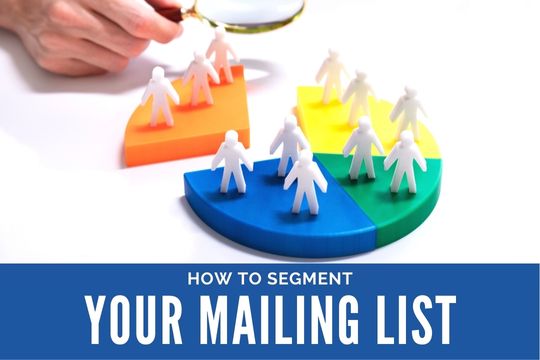
Segmenting your mailing list is the next logical step in your effort to engage a subscriber base. Do you know how to segment your mailing list effectively?

You have spent considerable time crafting various types of email communications for subscribers. Customers may have signed up for newsletters, offered their contact information because of a call to action in a blog post, or signed up for promotions. Over time, your originally small group has grown into a list of customers with very different needs throughout the sales funnel.
Email marketing campaigns lose some effectiveness because recipients’ needs are so diverse. Segmented emails are the practice of dividing your master list into smaller groups of individuals. However, there’s more to learning how to segment your mailing list than simply making mathematical divisions. Expertly segmented lists have the potential to boost click-through rates. That said, the reverse is also true.
To connect with the right people at the right times, segment your list based on various options that work well for your business.
Back then, you were just happy to get the ball rolling and get signups. However, since your company grew and you offered new options for your customers, the makeup of the email recipients is now more homogenous. You now have the dilemma of dealing with customers with vastly different needs and wants.
Because target emails are the key to growing the company, a logical segmentation is the right step. You can now target the interests of each segment. If you make a mistake here, there’s a good chance that recipients won’t open your emails or even unsubscribe from your list.

So far, we’ve discussed the needed entry-level knowledge that explains how to segment your mailing list. It’s an excellent starting point for the next level, where you can manipulate the segments to meet your goals of moving customers along the sales funnel. Also, going through the segments based on interests, purchase history, and interests to make additional groupings is vital to guarantee that your customers find your emails relevant to them.
Insiders have found that something as simple as reducing segments to no more than 35 subscribers can significantly boost your open rates and reduce unsubscribe requests. While it doesn’t make sense to target an email to each individual, it is possible to do so to smaller groupings. Best of all, once you narrowly define the segment elements, it’s easy to move customers between the groups as needed.
Curating an email list is challenging if you’re busy selling products or services. The same goes for the business owner or manager who’s also dealing with human resources issues and the overall upkeep of the facility. (Have you been asked to develop creative office break room ideas?) An excellent email marketing platform can make a big difference.
It cuts down on the time you spend learning to segment your mailing list and lets you get to work. We’ve already discussed a basic segmentation model: interests, preferences, and purchase history. Now, you can segment these groups even further.
A sub-segment of your email list could focus on your relationship with the business. For example, you sell widgets. Set up lists for suppliers, brick-and-mortar vendors, customers, influencers, and altruistic endeavors. It lets you connect with the person who sells your products which is bound to have different needs from the customer who buys directly from you.
Similarly, influencers want to be on the cutting edge and are the ones who can be testers of new products. If someone only knows you from your donations to non-profit organizations, you have another segment that you would address different from the repeat buyer.

The post-purchase survey is an excellent segmentation tool that many retailers and service providers have picked up on. You’ve gotten them. They ask, “how are we doing?” You get to weigh in on customer service, the speed of receiving a product, or the problems you had along the way. These surveys are not just suitable for improving the customer experience. They’re also suitable for sorting customers into email segments. Someone with many problems with your business needs to be marketed differently than a happy customer who has become a brand ambassador.
It seems like a huge task, but is it really worth it? Well, the answer is Yes! We’ve already talked about higher click-through rates and fewer unsubscribers. However, another added benefit to this practice is an increased open rate. Instead of leaving your email closed until a better time, the reader will be so interested in your offer that they’ll open it immediately. This interest easily affects conversion rates. The customer checks something out on your website, making them much more likely to complete a purchase. Typically, higher conversion rates lead to more sales.
If you’re a business owner or manager who doesn’t have time to segment your mailing list, you should get someone to help. At E-Marketing Associates, our mission is to help small businesses grow. So if you need help segmenting your mailing list, or you’re looking for a person who designs websites, our Business Growth Advisors are here to help!
Segmentation means splitting your main subscriber list into smaller groups that share traits like interests, location, or purchase history. Targeted emails feel more relevant, raising opens, clicks, and sales while lowering unsubscribes.
Common criteria include interests collected from surveys, stated content preferences, past purchases, browsing behavior, geographic location, customer type such as supplier or influencer, and feedback from post-purchase surveys. Choose factors that match your goals.
Aim for segments of roughly 35 subscribers or fewer. Small groups let you craft highly specific messages without creating one-to-one emails, leading to higher open rates and fewer unsubscribe requests.
Review and refresh segments regularly, at least every quarter. Subscriber interests, locations, and life-cycle stages change, so updating data, running new surveys, and moving contacts between segments keeps messages relevant.
Dedicated email marketing platforms such as Mailchimp, Constant Contact, or HubSpot provide drag-and-drop segmentation, purchase and browsing tracking, automated surveys, and dynamic lists, saving you time and ensuring accurate targeting.